Scotland and the sustainable development goals: a national review to drive action
This review provides a statement of our pre-COVID-19 ambition on driving progress towards the United Nations Sustainable Development Goals in Scotland. It brings together evidence, actions and stories of how we are making progress to meet the Goals.
6 Clean Water and Sanitation
- Children
- Communities
Scotland is renowned worldwide for the environmental quality of its rivers, lochs, wetlands and seas. They are some of the country’s greatest natural assets; attracting visitors, contributing to the health and wellbeing of its people, supporting a rich diversity of wildlife and providing for the sustainable growth of its economy. Maintaining this reputation is important for Scotland’s continued economic success and wellbeing. As well as being used for drinking, water is used by industry (e.g. distilling whisky and supporting fisheries), for producing energy (hydropower), and for recreational activities such as bird-watching, angling and water sports. Scotland has more than 125,000 km of rivers and streams varying from small highland burns to deep, wide lowland rivers such as the Tay, as well as a 220 km Canal network.
Scotland is the world’s first Hydro Nation, aiming to be a world leader in the responsible management of water resources. This means managing our water environment and resources to best advantage, and employing our knowledge and expertise effectively at home and internationally, to help improve people’s lives. This includes the governance and responsible management of water resources, the performance of our water industry, the role of our water research community in developing international research programmes on key issues; and our approach to develop the value of all of our water resources for the economy.
Clean water and sanitation (targets 6.1 and 6.2)
Water charges in Scotland are on average £46 less than in the rest of the UK. We are acutely aware that households face many pressures on their budgets and we are committed to working with customers and other stakeholders to ensure charges remain as affordable as possible whilst meeting the investment needs that maintain these vital services. Universal access to safe and clean water and access to sanitation are met in Scotland. The Scottish Government has committed to average water charges rising by less than inflation in the 2015-21 period, and for low income households assistance is available with up to 25% reduction in water and sewerage bills linked to the Council Tax Reduction Scheme.
Publicly owned Scottish Water - who make a vital contribution to the Hydro Nation strategy to develop the value of Scotland’s water resources – provides vital water and waste water services, essential to daily life, to 2.52 million households and 153,000 business premises across Scotland. Each day Scottish Water provide 1.38 billion litres of clear, fresh drinking water and take away 929 million litres of waste water (target 6.2), which is treated before returning safely to the environment. About 3.6% of the population (196,000 people) are served by private water supplies and 7% by private sewerage arrangements.
Local Authorities regulate private water supplies with oversight by the Drinking Water Quality Regulator for Scotland. The Scottish Government provides financial support for owners and users of private water supplies to support improvements to the quality of their supply through the provision of a non-means tested grant of up to £800 per property. These are available from local authorities to all who own or use a private supply. In 2017/18, £429,968 was awarded for improvements. According to the data provided by local authorities this funding improved 347 supplies[9]. Plans were put in place, through close working by Local Authorities and Scottish Water, to provide emergency supplies of water for domestic purposes to households and businesses served by private supplies who were affected by the water scarcity events of the summer of 2018.
Water is of central importance to the economy of Scotland, both as a sector in its own right and as a critical resource in the manufacturing, agriculture, food and drink, tourism and energy sectors. It also holds important non-economic value, as the quality of Scotland’s water environment contributes to both the nation’s wellbeing and sense of national identity. What underlies this understanding is a vision of Scotland safeguarding its natural resources responsibly regardless of how plentiful they are. This recognition is enshrined in law through the Water Resources (Scotland) Act 2013, which places a duty on Scottish Ministers to develop the value of our water resources in a responsible way (target 6.4, indicator 6.4.1 and 6.4.2).
As part of its ambition in leading innovation in water management, Scotland is a participant in the Organisation for Economic Co-operation and Development (OECD) Water Governance Initiative as one of 12 pilot countries to test the draft indicator framework to support the implementation of the OECD Principles on Water Governance. Scottish Government engaged with a range of stakeholders in undertaking this pilot. Through this engagement, we are developing an action plan to further strengthen and improve Scotland’s water governance.
The ‘Your Water, Your Life’ campaign, launched by Scottish Water in June 2018, aims to make ‘tap’ the first choice of Scotland’s water drinkers, for the environment, their health and their pocket. The campaign was launched to encourage people to carry a refillable bottle and top up from the tap (also contributing to Goal 12, target 12.5).
Scottish Water is also directly contributing to the wider SDG agenda, having reduced its operational carbon footprint by nearly 32% since it started reporting it in 2006/07. Scottish Water’s water service continues to have the lowest carbon intensity in the UK, and the carbon intensity of waste water service is lower than the UK average.
The Data Picture: Surface Water Status
Target 6.1 By 2030, achieve universal and equitable access to safe and affordable drinking water for all.
Column graph showing the percentage of water bodies by their classification from 2015 to 2017. There is little change over the period, with the percentage of bodied classfied as "high" remaining at 10% across the period. The percetage classifed as "good" dropped from 46% in 2015 to 45% in 2016, but recovered to 46% in 2017. Water bodies classified as "moderate" increased from 24% in 2015 to 25% in 2016, and remained at 25% in the following year. Water bodies given a classficiation of "poor" was 16% in 2015, dropped to 15% in 2016 and remained at 15% in 2017. Water bodies given the "bad" classification remained at 5% over the period.
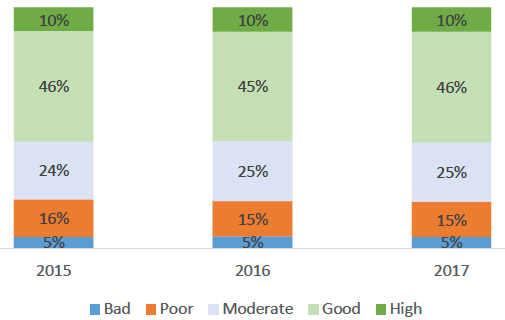
Source: Scottish Environmental Protection Agency
Closer Look - Water and waste water test facilities
The European INTERREG programme has granted funding to Scottish Water and six partner organisations to create a North-West European network of water and waste water test facilities to support innovation within the small-medium enterprise (SME) market.
The partnership consists of water utilities, research institutes and economic development agencies from Belgium, France, Germany, Ireland, Scotland and The Netherlands. Scottish Water is the lead partner, whilst its commercial subsidiary, Scottish Water Horizons, will project manage and deliver the project.
The project mirrors and extends the Hydro Nation Water Innovation Service model to include international partner businesses and uncover investment opportunities, setting ambitious targets for the numbers of businesses/products supported and tested during the project period. Through access to test facilities and innovation vouchers, innovators will be able to test, demonstrate and verify technologies on location, which will accelerate market uptake and provide an investor-ready pipeline of new products and processes. The project has a target that 120 innovators will be supported by testing 90 new technologies. This funding award was the only successful UK-led project in this round and represents an excellent result for Scotland and Hydro Nation given the close involvement of a range of key stakeholders in bid preparation and support, including Scottish Enterprise and the Scottish Government.
Rural service provision for drinking and waste water (targets 6.2, indicator 6.2.1)
Work on rural provision continues at pace, with further trials on small community supply water treatments technologies at Scottish Water’s Development Centre for Water at Gorthleck. The first round of trials suggest that multi-stage treatment will be required for the most complex rural waters and so the next step is to test combinations of treatment approaches to establish potential resilient treatment solutions. On waste water provision, a research project is being initiated looking at alternative treatment approaches. A pilot first time provision scheme for private supply users is now under consideration for the 2021-2027 period. Scottish Water is supporting research that will help build criteria for identifying communities that are most in need of water infrastructure support in rural areas.
Blue-Green cities
Scottish Water will also join the international trend towards Blue-Green cities by addressing the management of surface and storm water. Blue-Green cities bring water management and green infrastructure together to provide high quality places for public amenity and help reduce flooding.
The Water Framework Directive (targets 6.3, 6.4 & 6.6 and indicators 6.3.2, 6.4.1 and 6.6.1)
The Water Framework Directive (WFD) 2000/60/EC is an EU directive which commits European Union member states to achieve good qualitative and quantitative status of all water bodies. Scotland implements the aims and objectives of the WFD through The Water Environment and Water Services (Scotland) Act 2003. The WFD introduced a comprehensive river basin management planning system to help protect and improve the ecological health of our rivers, lakes, estuaries and coastal and groundwaters. This is underpinned by the use of environmental standards to help assess risks to the ecological quality of the water environment and to identify the scale of improvements that would be needed to bring waters under pressure back into a good condition.
River Basin Management Plans
Improvement measures to raise 87% of water bodies to Good by 2027 are prioritised through the River Basin Management Plans (RBMP). River basin management planning aims to protect and improve Scotland’s freshwater environment in a way that balances costs and benefits to the environment, society and economy (target 6.6). Scotland’s second RBMPs 2015-2027 are available.
The SEPA is working in partnership with other public bodies, industry and land managers to protect and improve the water environment by integrating the RBMP objectives into land use planning and flood risk management. The current condition of water bodies in Scotland is improving, however, a wide range of pressures are continuing to impact on the condition of a small number of water bodies and protected areas.
There is also a continued effort to prevent deterioration of water bodies from High and Good status. The table below gives an indication of the projects being undertaken by SEPA in collaboration with relevant stakeholders to achieve SDG targets 6.3 and 6.6.
The Data Picture: Water Framework Directive
Target 6.3.2 aims to increase the proportion of bodies of water with good ambient water quality.
Column graph showing the action progressing to address pressures affecting the overall condition of surface waters by number of surface waters in 2018. Man-made barriers to fish migration are pressuring the most surface waters, at around 400, with the majority of actions being ongoing, or not required. Modifications to physical condition has the second greatest at just over 300 surface waters under pressure, with the majority of actions not being due in this reporting period. Rural diffuse population pressures around 250 surface waters, with actions mostly being on-going or not yet started. Unknown sources are also pressuring around 150 surface waters, with actions to address these being either ongoing or not required, with a small number of actions complete. Hydroelectricity generation is pressuring under 100 surface waters, with more than half of actions not due this period. Waste water discharges also pressures around 100 surface waters, with the action progressed fairly equally divided between complete, not required, ongoing or not due for this period. Agricultural irrigation pressures around 70 surface waters, with the vast majority of actions ongoing. Use by other industries impacts around the same number of surface waters, with around half of actions not due this period. The remaining pressures are impacting less than 50 surface waters, with the majority of actions ongoing.
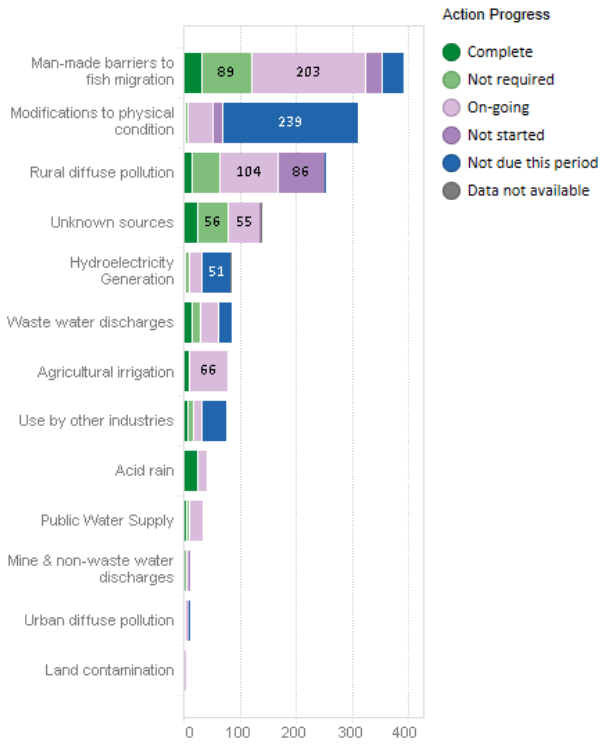
Source: Scottish Environmental Protection Agency
The work being undertaken in Scotland to achieve SDG target 6.4 and 6.6 are being driven by the Water Framework Directive River Basin management Plan cycle timescales ending in 2027.
Bathing Water Directive (target 6.3)
Improving Scotland’s water environment is a priority. The Bathing Water Directive (2006/7/EC) gives certain areas of water, that are popular for bathing, special protection to ensure they are safe for people to swim in. The Scottish Government funds SEPA to produce a report on the quality of Scottish bathing waters every year after the conclusion of the bathing season. Scotland has 86 designated bathing waters where water quality is monitored from 15 May to 15 September. The general water quality condition for each location is described by a classification statement – excellent, good, sufficient and poor – based on four years of monitoring data. These classifications are calculated at the end of one season for display at the start of the following season.
The Data Picture: Bathing Waters
Target 6.3.2 aims to increase the proportion of bodies of water with good ambient water quality.
Bathing water quality is described by one of four classification types; excellent, good, sufficient or poor in the Bathing Water Directive (2006/7/EC). The classification is based on several years of monitoring data to indicate the status of normal water quality at each location.
Column graph showing the percentage of bathing waters classified as being in excellent, good, sufficent or poor status from 2015 to 2018. The percentage classified as "excellent" jumps from 17% in 2015 to 28% in 2018. The percentage classified as good flucated between 38% in 2015 and 34% in 2018, while the percetage classfied as "sufficent" shifted between 12% in 2015 to 13% in 2018. The percentage classfied as "poor" dropped from 17% to 11% over the period.
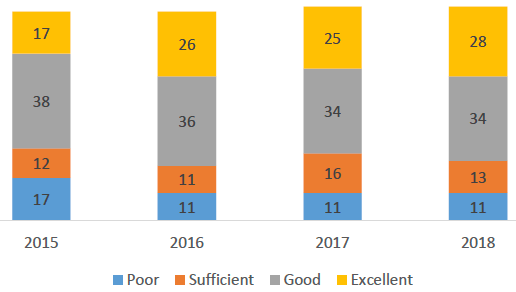
Source: Scottish Environmental Protection Agency
Improving water quality for wetland restoration: Loch Leven (targets 6.3, 6.5, 6.6 and 6b)
Loch Leven is a large, shallow lake in the Scottish lowlands. It is a Ramsar site, Special Protection Area and National Nature Reserve, largely due to its internationally-important wetland bird populations. For many years, the lake was polluted by discharges from industry and waste water treatment works, and by runoff from agricultural land. These sources introduced large amounts of pesticide and phosphorus pollution into the water, causing frequent algal blooms that impacted the biodiversity and reduced the amenity value of the system. In 1992, an especially large algal bloom resulted in the loss of more than £1 million of income to the local economy over a 3 month period.
Between 1985 and 1995, the phosphorus input to the lake was reduced by about 60% (Goal 6.3). This was achieved by implementing integrated water management (Goal 6.5), through establishment of the Loch Leven Catchment Management Group. This group successfully drove forward management measures to upgrade the waste water treatment works, reduce pesticide and phosphorus discharges from an industrial source, and create buffer strips to reduce the level of agricultural runoff reaching the lake. Although, initially, water quality improvements were slowed by legacy pollution from the lake sediments, by 2007 water quality had begun to improve dramatically (Goal 6.3). By 2012, there were less algal blooms and the water was much clearer. This allowed underwater plants to recolonise areas of deeper water, providing better habitat for wildlife (especially fish and birds) and restoring the biodiversity of the area, including plants last recorded more than 100 years ago (Goal 6.6). The restoration has allowed the site to become an important community asset for recreation through construction of an accessible, but biodiversity-friendly, heritage trail around the lake and the development of a number of small local businesses benefiting from the increased number of visitors.
The Centre for Ecology and Hydrology (Edinburgh) and Scottish Natural Heritage have hosted visitors that are keen to learn from this success story, including lake managers from China, India and Indonesia, and participants at a number of international scientific conferences on ecosystem management (Goal 6.A). Many of the lessons learned by taking this catchment-based approach to improving the water quality at Loch Leven are being used to underpin management decisions aimed at improving lake water quality and amenity value in developing countries, such as China, India, Kenya and Indonesia.
Closer Look - Peatland ACTION
Peatland ACTION is the project helping to restore damaged peatlands in Scotland. Since 2012, almost 20,000 hectares have been put on the road to recovery with funding provided by the Scottish Government. With 70% of drinking water supplies coming from upland catchment areas that have peatlands within the UK, this project plays an important role in maintaining high quality drinking water supplies in many areas. The project works with an extremely wide range of national and local partners to restore our internationally important peatlands, one of Scotland’s largest degraded ecosystems, as well as help us mitigate the effects of climate change. The project has been recognised by the Chartered Institute of Ecology and Environmental Management – winning their Best Practice Large Scale Nature Conservation Award in 2016, and received the Innovation Award from RSPB’s Nature of Scotland Awards.
River restoration (target 6.6)
Rivers harbour high levels of biodiversity, providing opportunities for recreation and wellbeing and resources for farming, drinking water, beverage production and hydroelectricity (target 6.6). River habitats are degrading due to a variety of anthropogenic pressures such as modification by straightening and heavily concreting channels; barriers to fish migration and river bank damage due to invasive non-native species (see Goal 15 chapter). To facilitate this programme of work, the Scottish Government established a Water Environment Fund utilising circa £5 million of annual funding, which is administered by SEPA. The Water Environment Fund (WEF), alongside Greener Scotland and SEPA, enables repair of urban rivers in deprived areas to enhance community wellbeing and health and funds removal of barriers to fish migration. Since 2009 SEPA has eased 41 barriers to fish passage resulting in 1069 km of habitat being made available to Scotland’s migratory fish species. Scoping and design work is underway on a further 209 fish barriers.
A multiple project partnership, and match funding from SEPA through the WEF, provided an opportunity for delivering improvements to the water environment in the River Glazert and River Tyne catchments. This WEF funded work was part of the larger EcoCo LIFE project.
Closer Look – Water Environment Fund restoration project
The Rivers and Fisheries Trusts for Scotland, Galloway Fisheries Trusts and SEPA worked in partnership to remove a 3.5m high weir on a tributary of the Tarff Water in Dumfries and Galloway, This has opened up 10km of fish habitat with salmon fry found upstream less than one year after works were completed (target 6.6).
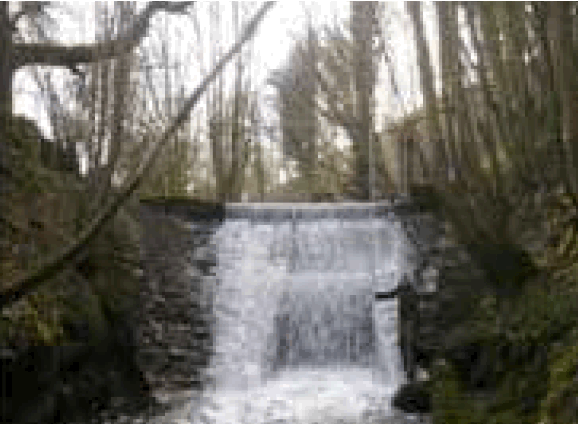
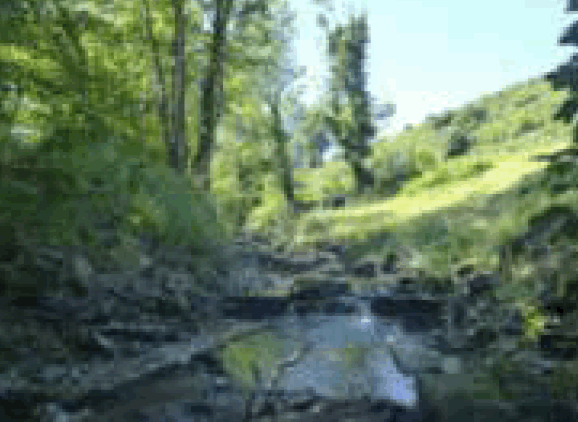
Source: Scottish Environmental Protection Agency
Closer Look - Pearls in Peril
The Pearls in Peril project focused on physical restoration of rivers in priority catchments to benefit freshwater pearl mussel, salmonids and trout. It was a UK wide EU LIFE funded project (2012-2017) including 22 partners, such as Scottish Natural Heritage, National Parks, Forestry Commission and Forest Enterprise Scotland, SEPA, Environment Agency, Natural Resources Wales, Fisheries Trusts and Boards, and water companies. Within Scotland the project created native riparian woodlands along approximately 100km of riverbank, and established livestock fencing along more than 60km of riverbank to reduce diffuse pollution. The project has been identified by the UK River Restoration Centre as the “best partnership project” in the UK. It contributes to Goals 6, 14, and 15.
Flood risk management in Scotland (targets 6.5 and 6b)
The Flood Risk Management (Scotland) Act 2009 has implemented a range of flood risk management strategies between 2016-2021. The Act works on a whole catchment scale approach, taking action based on risk-based decisions (target 6.6). Across the strategies there are 42 prioritised flood protection schemes which will help reduce the risk of flooding in many communities. Fourteen new flood warning schemes will be implemented between 2016- 2021. Ten thousand of the most vulnerable properties will be protected from schemes which deliver formal flood protection or engineering works.
The Data Picture: Scotland’s flooding future
Target 6.6: By 2020, protect and restore water-related ecosystems, including mountains, forests, wetlands, rivers, aquifers and lakes.
Anthrophonic pressures, modifications and climate change can contribute to the risk of flooding in Scotland.
Graphic shows a pie chart outlining the breakdown of expected £252 million cost of annual flood damage, with 56% being due to river flooding, 23% to surface water flooding and 21% to coastal flooding. A second graphic shows that of 108,000 properties at risk of flooding, 73% are residential. A third graphic explains that 2000km of road network and 200,000 hectares of land are at risk of flooding, and 500km of rail passes through high risk areas.
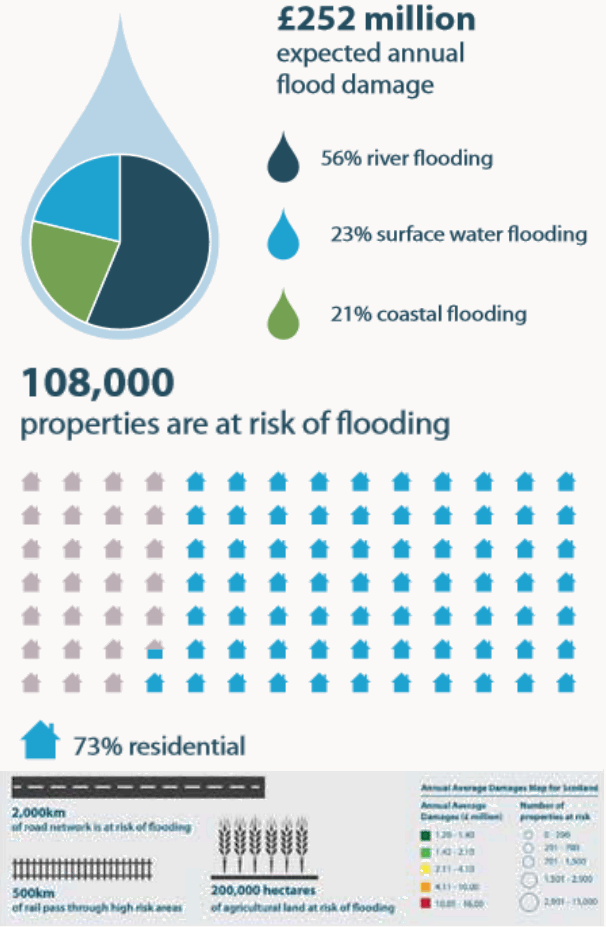
Source: Scottish Environmental Protection Agency
Scotland’s canals (targets 6.1 and 6.4, and indicators 6.1.1, 6.4.1 and 6.4.2)
Scotland’s canals, once the catalysts of the Industrial Revolution, have been reimagined to contribute positively to Scotland’s circular economy offering a wide range of sustainable and long term benefits for the many people of Scotland, as well as the few.
Valuable fresh water: The 332 million litres of water used daily to operate Scotland’s canals have the potential for multiple re-use functions. Canal water has a significantly lower carbon footprint than drinking water as it is 95% gravity fed and currently provides permanent supplies to industry and for recreational activities including supplying the Falkirk Wheel water play parks.
Energy generation: Public body Scottish Canals is currently investigating the potential to generate renewable energy from canal water including low head hydropower schemes and water source heat pumps to offset their carbon footprint.
Biodiversity value: Scotland’s 200-year-old canals are home to a wide range of plants and animals including protected species such as otters, bats, and plants, which are rare elsewhere in the UK.
Waste re-use: Scottish Canals is collaborating with organisations from across Europe in the Interreg North-West Europe SURICATES funded project investigating ways to increase the re-use of canal and port waste sediments for erosion and flood control. A high proportion of the 200 million m³ of dredged sediments from across Europe produced each year is currently disposed of at sea; Scottish Canals along with partners are leading the way in testing new uses for this material from road surfaces to paths and even bricks.
Sustainable transport: Our canal network attracts over 22 million visits per annum in partnership with Sustrans; Scottish Canals has upgraded the towpath network offering safe, accessible traffic free routes for all the people of Scotland. To further reduce transport emissions Scottish Canals is in positive discussions with Scottish and Southern Energy on the Coire Glas pumped storage hydropower scheme on Loch Lochy to use the Caledonian Canal for water-based freight transport.
Local participation in water management (target 6b)
2020 has been designated Scotland’s Year of Coasts and Waters, a year that will spotlight, celebrate and promote opportunities to experience and enjoy Scotland’s unrivalled coasts and waters, encouraging responsible engagement and participation from the people of Scotland and our visitors. This includes a programme of special events, funded via the Year of Coasts and Waters 2020 (YCW2020) Events Programme Open Fund, designed to create new, high profile opportunities to celebrate Scotland’s coasts and waters whilst adding value to the existing calendar of events. The funded events programme will create new opportunities for responsible participation, celebration and promotion of the key themes. The four programme strands that we invite events to respond to and celebrate are: Our Natural Environment and Wildlife; Our Historic Environment and Cultural Heritage; Activities and Adventure; Food and Drink. A total of £600,000 has been made available across two funding rounds. Partners include Scottish Government, public bodies, National Lottery Heritage Fund (and others). This programme contributes to SDG 6, 14, and 15.
Closer Look - Water-related expertise
Scotland’s Centre of Expertise for Waters (CREW), managed on behalf of the Scottish Government by the James Hutton Institute, is a partnership between all of Scotland’s Universities to develop the coordination of research, analysis and interpretation across the subject area. The aim of CREW is to brigade the best expertise on the management of water, to simplify access by policy teams to water-related expertise from across Scotland and to stimulate innovative thinking in support of water policy for the implementation partners (Scottish Government, SEPA, SNH, and Scottish Water).
Scottish Invasive Species Initiative (targets 6.6 and 6b, indicators 6.6.1 and 6.b.1)
The Scottish Invasive Species Initiative (SISI) is a four-year partnership project which aims to work with local organisations and volunteers to control invasive non-native species along riversides in Northern Scotland. It is led by Scottish Natural Heritage and funded together with the National Lottery Heritage Fund and in-kind support from project partners and volunteers. Project staff are working with the ten Fisheries Trusts/Boards who look after the rivers from the Tay in the south to the remote catchments of North West Sutherland, to recruit and train volunteers and work with local groups to enable control of invasive species at a local level, embedded in their community. The project started in 2018, and during the year was successful in working communities to contribute a total of 2,319 days of volunteer effort. After the project ceases in 2021 our aspiration is that local community control of invasive species will continue, making this a sustainable long‑term solution to invasive species control.
The project is targeting invasive riparian plant species and American mink, which can have a debilitating effect on local rivers. This is an ambitious project, aiming to create a sense of cohesion between partners, volunteers and communities and working at a large-scale across a third of Scotland to ensure co‑ordinated invasive non-native species (INNS) control.
Upstream Battle (targets 6.3 and 6b, indicator 6.3.2 and 6.b.1)
In 2018, Keep Scotland Beautiful launched the source to sea campaign Upstream Battle, initially focused on the River Clyde the campaign is changing behaviour and tackling marine litter at source given that 80% of litter comes from land. Working with communities along the river and its tributaries, Keep Scotland Beautiful will work with 16 Anchor Groups to survey and clean up their local area, contribute to a Clyde-wide litter prevention plan and inform decision making. In addition to this, the campaign will be working to make sure that everyone who lives or works near the River Clyde or one of its tributaries knows about the extent of the marine litter problem and is motivated to keep the Clyde clean. The final strand of the project involves working with children and young people to motivate them to reconnect with the River Clyde and to become more aware of potential litter causes and prevent waste.
International (targets 6.2 and 6.5)
Due to Scotland’s status as the world’s first Hydro Nation and its unique and internationally respected model of governance and regulation and an innovative approach to water policy there is a huge amount of international activity.
A significant milestone has been reached in the Water Futures Project in Malawi project, as now over 55% of mapping its national water asset is complete. Round one mapping was completed in March 2018. Round one mapped over 47000 water points and submitted 75347 sanitation surveys across eight districts across the Lower Shire. This effort is providing an open data resource to evaluate the risks and help address water gaps to a population of 4,852,405 people. National Evaluation mapping continues in 15 districts in the Central Region and Southern Region. To date (22 February 2019), the Programme has mapped 59,825 water points, 194,873 sanitation facilities and 4047 waste disposal sites. Several districts are approaching completion. The two-level approval approach ensures high quality data.
At the Commonwealth Heads of Government meeting held in London in April 2018, the Scottish Government signed a Memorandum of Understanding/Collaboration Agreement with the National Mission for Clean Ganga on behalf of the wider Hydro Nation family. This will support more detailed discussions between Scotland, the Hydro Nation and India around opportunities for scientific cooperation and collaboration.
Since the establishment of the Hydro Nation Commercial and Advisory Services Group, a number of stakeholders have been successfully awarded further significant projects to deliver Scottish expertise and knowhow, including:
- Governance assistance project in Romania to deliver improvement of River Basin Management Planning support. Discussions are already ongoing for a follow-up Phase 2 project (HNCAS lead Water Industry Commission Scotland (WICS) – Consortium includes SEPA and Scottish Water International)
- SEPA have successfully closed out a significant contract in Cyprus, assisting with the establishment of a new legal and institutional framework for an integrated environmental permitting and inspection system, and are in discussion for follow-up training projects (HNCAS lead – SEPA). Leading HNCAS stakeholders Scottish Water/WICS/SEPA are working together on a formal Business Plan over the next 2-4 years to underpin joint activity
Other work has been completed, or is ongoing by HNCAS partners in China and Czech Republic, led by WICS, who are also developing collaboration MoUs with Latvia, Bulgaria and Kosovo covering training and consultancy support.
The Centre for Water Law, Policy and Science at the University of Dundee has been leading work on the Hydro Nation–funded Ganga River Health Project (c. £270,000 over the last and current financial years) which aims to provide a framework for the Centre for Ganga River Basin Management and Studies (CGANGA), supported by the Government of India Ministry of Water Resources, River Development and Ganga Rejuvenation, to determine how research, policy support and capacity building can support the infrastructure development required to restore Ganga water quality and support socio-economic, governance and social benefits.
We are now considering follow-up work focusing on legislation, regulation and implementation of water policy. These projects can help increase the profile of Scotland’s water research capability in a global context as well as making a valuable contribution in the spirit of Scotland’s commitment to the SDGs.
Challenges and next steps
Scotland is well on track to meeting this goal now. The challenge moving forward will be resilience to climate extremes. Recent evidence indicates that climate extremes are not only becoming a reality in Scotland, but their severity and frequency is increasing. The summer of 2018 was a clear example, a summer drought particularly affected the North and East of Scotland with record low flows observed in several Scottish rivers. Scotland should aim to use less water moving forward which will involve a change in consumer attitude towards a more sustainable usage.
Scottish Water will promote increased water efficiency in domestic and non-domestic settings, reduce energy consumption in water and waste water services and produce renewable energy from water resources and assets. The Scottish Government will continue to engage with its stakeholders across Scotland and encourage them to share their observations, experiences, research outcomes, and innovative ideas on building resilience and adapting to low flows and drought conditions.
Commitments in the Scottish Government’s 2019-20 Programme for Government that relate to this Goal
- In 2020 the Scottish Government will run a competition across Scotland’s universities to establish a Hydro Nation Chair to help Scotland’s water industry manage the challenges of climate change
- Committing to planting 12,000 hectares of woodland, supported by an additional £5 million investment
- An investment this year of £14 million to fund projects to restore degraded peatlands and seeking to phase out the use of horticultural peat
- Launching later this year, a two-year action plan for flood-resilient repairs and property level flood protection to ensure that property owners are aware of and take up the available support
Contact
Email: nationalperformance@gov.scot
There is a problem
Thanks for your feedback